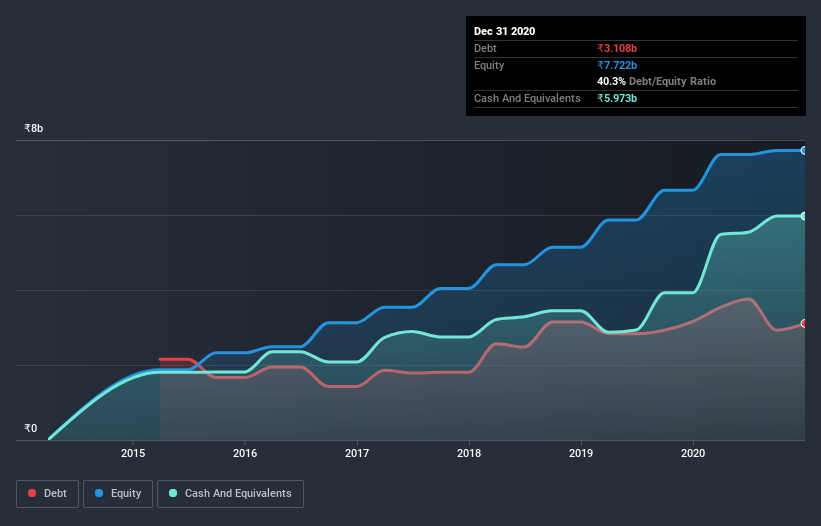These 4 Measures Indicate That Gulf Oil Lubricants India (NSE:GULFOILLUB) Is Using Debt Reasonably Well

The external fund manager backed by Berkshire Hathaway's Charlie Munger, Li Lu, makes no bones about it when he says 'The biggest investment risk is not the volatility of prices, but whether you will suffer a permanent loss of capital.' When we think about how risky a company is, we always like to look at its use of debt, since debt overload can lead to ruin. We note that Gulf Oil Lubricants India Limited (NSE:GULFOILLUB) does have debt on its balance sheet. But is this debt a concern to shareholders?
Why Does Debt Bring Risk?
Debt and other liabilities become risky for a business when it cannot easily fulfill those obligations, either with free cash flow or by raising capital at an attractive price. Part and parcel of capitalism is the process of 'creative destruction' where failed businesses are mercilessly liquidated by their bankers. However, a more common (but still painful) scenario is that it has to raise new equity capital at a low price, thus permanently diluting shareholders. By replacing dilution, though, debt can be an extremely good tool for businesses that need capital to invest in growth at high rates of return. When we examine debt levels, we first consider both cash and debt levels, together.
View our latest analysis for Gulf Oil Lubricants India
What Is Gulf Oil Lubricants India's Net Debt?
You can click the graphic below for the historical numbers, but it shows that Gulf Oil Lubricants India had ₹2.92b of debt in September 2020, down from ₹3.16b, one year before. But it also has ₹5.97b in cash to offset that, meaning it has ₹3.05b net cash.

A Look At Gulf Oil Lubricants India's Liabilities
We can see from the most recent balance sheet that Gulf Oil Lubricants India had liabilities of ₹5.71b falling due within a year, and liabilities of ₹266.4m due beyond that. Offsetting these obligations, it had cash of ₹5.97b as well as receivables valued at ₹1.53b due within 12 months. So it actually has ₹1.52b more liquid assets than total liabilities.
This surplus suggests that Gulf Oil Lubricants India has a conservative balance sheet, and could probably eliminate its debt without much difficulty. Simply put, the fact that Gulf Oil Lubricants India has more cash than debt is arguably a good indication that it can manage its debt safely.
It is just as well that Gulf Oil Lubricants India's load is not too heavy, because its EBIT was down 24% over the last year. When it comes to paying off debt, falling earnings are no more useful than sugary sodas are for your health. There's no doubt that we learn most about debt from the balance sheet. But you can't view debt in total isolation; since Gulf Oil Lubricants India will need earnings to service that debt. So when considering debt, it's definitely worth looking at the earnings trend. Click here for an interactive snapshot.
Finally, a business needs free cash flow to pay off debt; accounting profits just don't cut it. While Gulf Oil Lubricants India has net cash on its balance sheet, it's still worth taking a look at its ability to convert earnings before interest and tax (EBIT) to free cash flow, to help us understand how quickly it is building (or eroding) that cash balance. Over the most recent three years, Gulf Oil Lubricants India recorded free cash flow worth 54% of its EBIT, which is around normal, given free cash flow excludes interest and tax. This cold hard cash means it can reduce its debt when it wants to.
Summing up
While we empathize with investors who find debt concerning, you should keep in mind that Gulf Oil Lubricants India has net cash of ₹3.05b, as well as more liquid assets than liabilities. So we don't have any problem with Gulf Oil Lubricants India's use of debt. There's no doubt that we learn most about debt from the balance sheet. But ultimately, every company can contain risks that exist outside of the balance sheet. To that end, you should be aware of the 2 warning signs we've spotted with Gulf Oil Lubricants India .
Of course, if you're the type of investor who prefers buying stocks without the burden of debt, then don't hesitate to discover our exclusive list of net cash growth stocks, today.
When trading Gulf Oil Lubricants India or any other investment, use the platform considered by many to be the Professional's Gateway to the Worlds Market, Interactive Brokers. You get the lowest-cost* trading on stocks, options, futures, forex, bonds and funds worldwide from a single integrated account. Promoted
New: Manage All Your Stock Portfolios in One Place
We've created the ultimate portfolio companion for stock investors, and it's free.
• Connect an unlimited number of Portfolios and see your total in one currency
• Be alerted to new Warning Signs or Risks via email or mobile
• Track the Fair Value of your stocks
This article by Simply Wall St is general in nature. It does not constitute a recommendation to buy or sell any stock, and does not take account of your objectives, or your financial situation. We aim to bring you long-term focused analysis driven by fundamental data. Note that our analysis may not factor in the latest price-sensitive company announcements or qualitative material. Simply Wall St has no position in any stocks mentioned.
*Interactive Brokers Rated Lowest Cost Broker by StockBrokers.com Annual Online Review 2020
Have feedback on this article? Concerned about the content? Get in touch with us directly. Alternatively, email editorial-team (at) simplywallst.com.
About NSEI:GULFOILLUB
Gulf Oil Lubricants India
Manufactures, markets, and trades lubricating oils, greases, and other derivatives for use in the automobile and industrial sectors in India.
Outstanding track record with flawless balance sheet and pays a dividend.
Similar Companies
Market Insights
Community Narratives




